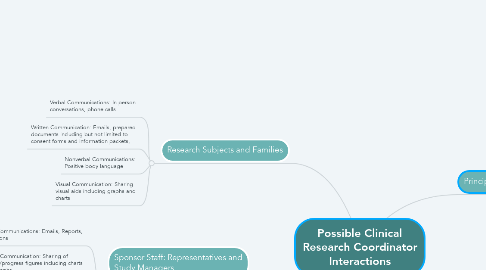Possible Clinical Research Coordinator Interactions
by Leanna Camilleri

1. Research Subjects and Families
1.1. Verbal Communications: In person conversations, phone calls
1.2. Written Communication: Emails, prepared documents including but not limited to consent forms and information packets,
1.3. Nonverbal Communications: Positive body language
1.4. Visual Communication: Sharing visual aids including graphs and charts
2. Sponsor Staff: Representatives and Study Managers
2.1. Written Communications: Emails, Reports, Submissions
2.2. Visual Communication: Sharing of results/progress figures including charts and graphs
2.3. Verbal Communications: Phone calls, in person discussions
3. Social Workers
3.1. Written Communication: Emails
3.2. Verbal Communications: Phone calls, in person conversations
3.3. Nonverbal Communications: Sharing of subject's body language and gestures
4. Medical Staff: Doctors, Clinical Fellows, Residents, Research Nurses and Pharmacists, Laboratory and Imaging Technologists, Interns, Medical Secretaries
4.1. Verbal Communications: Phone calls, in person discussions
4.2. Written Communications: Emails, sharing patient data, reports, documents, and results
4.3. Visual Communications: Sharing patient imaging results (i.e. ultrasound images, microscopy pictures, etc.), charts
5. Other Clinical Research Associates, Coordinators, Assistants
5.1. Written Communications: Emails, sharing and collaborating on reports, sharing documents and data
5.2. Verbal Communication: In person discussions, phone calls
5.3. Visual Communications: Sharing figures, images, charts
6. Principal Investigator
6.1. Verbal Communications: In person conversations, phone calls
6.2. Written Communications: Emails, reports, sharing documents, files and data
6.3. Visual Communications: Spreadsheets, sharing prepared figures including results graphs and charts, also sharing any pertinent images (i.e. ultrasound images)
6.4. Nonverbal Communications: Sharing of subject's body language and gestures
7. Regulatory Agency Staff: Health Canada Auditors and Representatives of the Research Ethics Board
7.1. Written Communications: Regulation Guidelines, Emails, submission reports including adverse side effect reports
7.2. Verbal Communications: Phone calls and potential in person discussions
8. Institution Review Board
8.1. Written Communications: Emails, reports, prepared institutional guidelines
8.2. Verbal Communications: Phone Calls and in person conversations
9. Data Management Team: Database Admins and Biostaticians
9.1. Written Communications: Emails, prepared reports
9.2. Visual Communications: Spreadsheets, result figures including charts and graphs
9.3. Verbal Communications: In person, phone calls
10. Site Manager
10.1. Written Communications: Emails, reports including budget reports
10.2. Verbal Communications: In person discussions, phone calls
10.3. Visual: Spreadsheets, figures including budget graphs and charts


